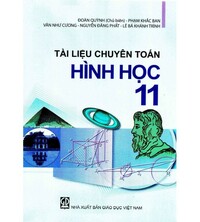Bài 1.30 trang 38 SBT đại số và giải tích 11
Giải bài 1.30 trang 38 sách bài tập đại số và giải tích 11. Giải các phương trình sau...
Giải các phương trình sau
LG a
\(1+\sin x-\cos x-\sin 2x\)
\(+2\cos 2x=0\)
Phương pháp giải:
Ta rút gọn phương trình bằng cách:
-Sử dụng công thức \({(\sin x-\cos x)}^2\)
\(={\sin}^2 x-2\sin x\cos x+{\cos}^2 x\)
\(=1-\sin 2x\)
-Sử dụng công thức nhân đôi \(\cos 2x={\cos}^2 x-{\sin}^2 x\)
Lời giải chi tiết:
Ta có: \(1+\sin x-\cos x-\)
\(\sin 2x+2\cos 2x=0\)
\(\Leftrightarrow (1-\sin 2x)+(\sin x-\cos x)\)
\(+2\cos 2x=0\)
\(\Leftrightarrow {(\sin x-\cos x)}^2+(\sin x-\cos x)\)
\(+2({\cos}^2 x-{\sin}^2 x)=0\)
\(\Leftrightarrow (\sin x-\cos x)[\sin x-\cos x+\)
\(1-2(\cos x+\sin x)]=0\)
\(\Leftrightarrow (\sin x-\cos x)(1-\sin x-\)
\(3\cos x)=0\)
\(\Leftrightarrow \left[ \begin{array}{l} \sin x-\cos x=0 \\1-\sin x-3\cos x=0 \end{array} \right. \)
\(\Leftrightarrow \left[ \begin{array}{l} \sin x=\cos x \\\sin x+3\cos x=1 \end{array} \right. \)
\(\Leftrightarrow \left[ \begin{array}{l} \tan x=1 \text{(1)}\\\dfrac{1}{\sqrt{10}}\sin x+\dfrac{3}{\sqrt{10}}\cos x=\dfrac{1}{\sqrt{10}}\text{(2)} \end{array} \right. \)
\(\text{(1)}\Leftrightarrow x=\dfrac{\pi}{4 }+k\pi,k\in\mathbb{Z}\)
Giải phương trình \(\text{(2)}\) ta đặt \(\dfrac{1}{\sqrt{10}}=\sin\alpha\) và \(\dfrac{3}{\sqrt{10}}=\cos\alpha\) ta được \(\cos\alpha\cos x+\sin\alpha\sin x=\dfrac{1}{\sqrt{10}}\)
\(\Leftrightarrow \cos(x-\alpha)=\dfrac{1}{\sqrt{10}}\)
\(\Leftrightarrow x-\alpha=\pm\arccos\dfrac{1}{\sqrt{10}},k\in\mathbb{Z}\)
\(\Leftrightarrow x=\alpha\pm\arccos\dfrac{1}{\sqrt{10}},k\in\mathbb{Z}\)
Vậy phương trình có nghiệm là: \( x=\dfrac{\pi}{4 }+k\pi,k\in\mathbb{Z}\) và \( x=\alpha\pm\arccos\dfrac{1}{\sqrt{10}},k\in\mathbb{Z}\).
LG b
\(\sin x-\dfrac{1}{\sin x}={\sin}^2 x-\dfrac{1}{{\sin}^2 x }\)
Phương pháp giải:
Tìm ĐKXĐ của phương trình.
Nhóm các số hạng với nhau để có nhân tử chung.
Lời giải chi tiết:
ĐKXĐ: \(\sin x\ne 0\)
Ta có: \(\sin x-\dfrac{1}{\sin x}={\sin}^2 x-\dfrac{1}{{\sin}^2 x }\)
\(\Leftrightarrow (\sin x-{\sin}^2 x)+\)
\({\left({\dfrac{1}{{\sin}^2 x}-\dfrac{1}{\sin x}}\right)}=0\)
\(\Leftrightarrow \sin x(1-\sin x)+\dfrac{1-\sin x}{{\sin}^2 x}=0\)
\(\Leftrightarrow (1-\sin x)({\sin}^3 x+1)=0\)
\(\Leftrightarrow \left[ \begin{array}{l} \sin x=1 \\\sin x=-1 \end{array} \right. \)
\(\Leftrightarrow \left[ \begin{array}{l} x=\dfrac{\pi}{2}+k2\pi,k\in\mathbb{Z}\text{(thỏa mãn)} \\x=-\dfrac{\pi}{2}+k2\pi,k\in\mathbb{Z}\text{(thỏa mãn)} \end{array} \right. \)
\(\Leftrightarrow x=\dfrac{\pi}{2}+k\pi ,k\in\mathbb{Z}\).
LG c
\(\cos x\tan 3x=\sin 5x\)
Phương pháp giải:
Tìm ĐKXĐ
Sử dụng công thức \(\tan 3x=\dfrac{\sin 3x}{\cos 3x}\)
Sử dụng công thức biến đổi tích thành tổng.
Lời giải chi tiết:
ĐKXĐ: \(\cos 3x\ne 0\)
\(\Leftrightarrow x\ne \dfrac{\pi}{6}+k\dfrac{\pi}{3},k\in\mathbb{Z}\)
Ta có: \(\cos x\tan 3x=\sin 5x\)
\(\Leftrightarrow \cos x\dfrac{\sin 3x}{\cos 3x}=\sin 5x\)
\(\Leftrightarrow \cos x\sin 3x=\sin 5x\cos 3x\)
\(\Leftrightarrow \dfrac{1}{2}(\sin 4x+\sin 2x)\)
\(=\dfrac{1}{2}(\sin 8x+\sin 2x)\)
\(\Leftrightarrow \sin 8x=\sin 4x\)
\(\Leftrightarrow \left[ \begin{array}{l} 8x=4x+k2\pi,k\in\mathbb{Z}\\8x=\pi-4x+k2\pi,k\in\mathbb{Z} \end{array} \right. \)
\(\Leftrightarrow \left[ \begin{array}{l} x=k\dfrac{\pi}{2},k\in\mathbb{Z}\\x=\dfrac{\pi}{12}+ k\dfrac{\pi}{6},k\in\mathbb{Z} \end{array} \right. \)
Kết hợp với ĐKXĐ ta được nghiệm của phương trình là \( x=k\pi,k\in\mathbb{Z}\) và \( x=\dfrac{\pi}{12}+ k\dfrac{\pi}{6},k\in\mathbb{Z}\).
LG d
\(2{\tan}^2 x+3\tan x+\)
\(2{\cot}^2 x+3\cot x+2=0\)
Phương pháp giải:
Tìm ĐKXĐ
Nhóm các số hạng một cách thích hợp để giải phương trình
Thêm bớt \(VT\) để có hằng đẳng thức
Lời giải chi tiết:
ĐKXĐ: \(\cos\ne0\) và \(\sin x\ne0\).
Ta có: \(2{\tan}^2 x+3\tan x+\)
\(2{\cot}^2 x+3\cot x+2=0\)
\(\Leftrightarrow (2{\tan}^2 x+2{\cot}^2 x)\)
\(+(3\tan x+3\cot x)+2=0\)
\(\Leftrightarrow 2[{(\tan x+\cot x)}^2-2\tan x\cot x]+\)
\(3(\tan x+\cot x)+2=0\)
\(\Leftrightarrow 2[{(\tan x+\cot x)}^2-2]+\)
\(3(\tan x+\cot x)+2=0\)
Đặt \(\tan x+\cot x=t\) ta được phương trình \(2t^2+3t-2=0\)
\(\Leftrightarrow \left[ \begin{array}{l} t=-2\\t=\dfrac{1}{2}\end{array} \right. \)
Với \(t=-2\) ta có \(\tan x+\cot x=-2\)
\(\Rightarrow \tan x+\dfrac{1}{\tan x}=-2\)
\(\Rightarrow {\tan}^2 x+1=-2\tan x\)
\(\Rightarrow \tan x=-1\)
\(\Rightarrow x=-\dfrac{\pi}{4}+k\pi,k\in\mathbb{Z}\text{(thỏa mãn)}\)
Với \(t=\dfrac{1}{2}\) ta có \(\tan x+\cot x=\dfrac{1}{2}\)
\(\Rightarrow \tan x+\dfrac{1}{\tan x}=\dfrac{1}{2}\)
\(\Rightarrow 2{\tan}^2 x+2=\tan x\text{(Vô nghiệm)}\)
Vậy phương trình có nghiệm là \( x=-\dfrac{\pi}{4}+k\pi,k\in\mathbb{Z}\).
Search google: "từ khóa + timdapan.com" Ví dụ: "Bài 1.30 trang 38 SBT đại số và giải tích 11 timdapan.com"







